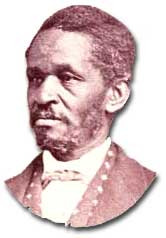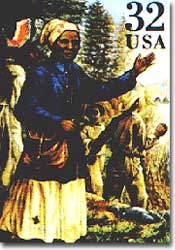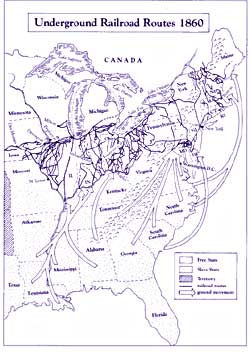28c. The Underground Railroad

Any cause needs speakers and organizers. Any mass movement requires men and women of great ideas.
But information and mobilization are not enough. To be successful, revolutionary change requires people of action — those who little by little chip away at the forces who stand in the way. Such were the "conductors" of the Underground Railroad. Not content to wait for laws to change or for slavery to implode itself, railroad activists helped individual fugitive slaves find the light of freedom.

Harriet Tubman is sometimes referred to as the Moses of her people because of the way she led them out of slavery.
The Underground Railroad operated at night. Slaves were moved from "station" to "station" by abolitionists. These "stations" were usually homes and churches — any safe place to rest and eat before continuing on the journey to freedom, as faraway as Canada. Often whites would pretend to be the masters of the fugitives to avoid capture. Sometimes lighter skinned African Americans took this role. In one spectacular case, Henry "Box" Brown arranged for a friend to put him in a wooden box, where he had only a few biscuits and some water. His friend mailed him to the North, where bemused abolitionists received him in Philadelphia.

This map of the eastern United States shows some of the routes that slaves traveled during their escape to freedom.
Most of the time, however, slaves crept northward on their own, looking for the signal that designated the next safe haven. This was indeed risky business, because slave catchers and sheriffs were constantly on the lookout. Over 3,200 people are known to have worked on the railroad between 1830 and the end of the Civil War. Many will remain forever anonymous.
Perhaps the most outstanding "conductor" of the Underground Railroad was Harriet Tubman. Born a slave herself, she began working on the railroad to free her family members. During the 1850s, Tubman made 19 separate trips into slave territory. She was terribly serious about her mission. Any slave who had second thoughts she threatened to shoot with the pistol she carried on her hip. By the end of the decade, she was responsible for freeing about 300 slaves. When the Civil War broke out, she used her knowledge from working the railroad to serve as a spy for the Union.
Needless to say, the Underground Railroad was not appreciated by the slaveowners. Although they disliked Abolitionist talk and literature, this was far worse. To them, this was a simple case of stolen property. When Northern towns rallied around freed slaves and refused compensation, yet another brick was set into the foundation of Southern secession.






